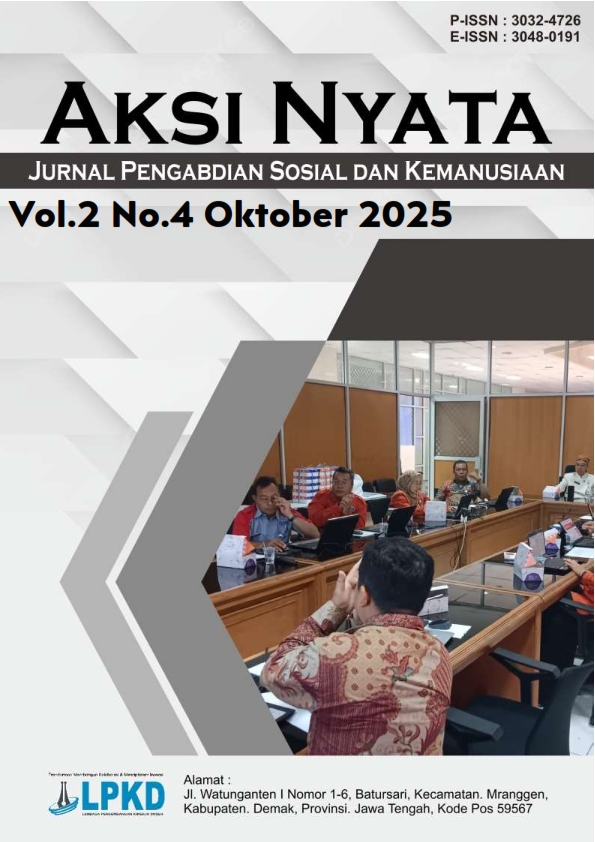Edukasi Masyarakat tentang Sifat Termal Sampah dan Dampak Negatif Pembakaran Plastik terhadap Lingkungan dan Kesehatan
DOI:
https://doi.org/10.62383/aksinyata.v2i4.2209Keywords:
Community Education, Environmental Health, Plastic Burning, Public Outreach, Thermal PropertiesAbstract
Semarang City has experienced significant growth over the past five years (2020 – 2025). Rapid urban development has been positively correlated with increasing environmental burdens, particularly in solid waste generation. In Indonesia, the largest portion of municipal waste consists of food waste, followed by plastic waste. Among these, plastic waste is the most difficult to manage. It is estimated that around 70% of Indonesian households still burn their waste as a means of disposal. The burning of waste, especially plastics, releases toxic emissions such as dioxins, furans, and fine particulates, which pose serious health risks, particularly to the respiratory system. This practice not only worsens air quality but also threatens public health. This community service program focused on providing education about the thermal properties of waste and the negative impacts of plastic burning on both the environment and human health. The program aimed to improve public knowledge of the thermal characteristics of various types of waste and the hazards of plastic burning through accessible scientific outreach. The initiative is expected to raise awareness and understanding of environmentally friendly waste management alternatives such as waste separation, composting, and recycling. The activity was conducted in RW 01, Tugurejo Village, Tugu District, Semarang City.
References
Badan Pusat Statistik. (2025). Laju pertumbuhan penduduk di Jawa Tengah. https://jateng.bps.go.id/id/statistics-table/2/MjIwNSMy/penduduk--laju-pertumbuhan-penduduk--distribusi-persentase-penduduk-kepadatan-penduduk--rasio-jenis-kelamin-penduduk-menurut-kabupaten-kota-di-provinsi-jawa-tengah.html
Faridawati, D., & Sudarti. (2021). Pengetahuan masyarakat tentang dampak pembakaran terhadap lingkungan Kabupaten Jember. Jurnal Sanitasi Lingkungan, 1(2). https://doi.org/10.36086/salink.v1i2.1088
Gewert, B., Plassmann, M. M., & MacLeod, M. (2015). Pathways for degradation of plastic polymers floating in the marine environment. Environmental Science: Processes & Impacts, 17(9), 1513-1521. https://doi.org/10.1039/C5EM00207A
Ismainar, H., Marlina, H., Afriza, B., & Atika, W. (2021). Gerakan mengurangi sampah plastik dan risiko membakar sampah dengan pemberian edukasi kesehatan melalui penyuluhan. Jurnal Pengabdian Kesehatan Komunitas (Journal of Community Health Service), 1(3), 188-195. https://doi.org/10.25311/jpkk.Vol1.Iss3.1031
Jadhav, E. B., Sankhla, M. S., Bhat, R. A., & Bhagat, D. S. (2021). Microplastics from food packaging: An overview of human consumption, health threats, and alternative solutions. Environmental Nanotechnology, Monitoring & Management, 16, 100608. https://doi.org/10.1016/j.enmm.2021.100608
Karuniastuti, N. (2013). Bahaya plastik terhadap kesehatan dan lingkungan. Jurnal SWARAPATRA, 3(1), 45-52.
Kroon, F. J., Motti, C. E., Jensen, L. H., & Berry, K. L. (2018). Classification of marine microdebris: A review and case study on fish from the Great Barrier Reef, Australia. Scientific Reports, 8, 16422. https://doi.org/10.1038/s41598-018-34590-6
Kurniaty, Y., Nararaya, W. H. B., Turawan, R. N., & Nurmuhamad, F. (2016). Mengefektifkan pemisahan jenis sampah sebagai upaya pengelolaan sampah terpadu di Kota Magelang. Varia Justicia, 12(1), 135-150.
Landi, T., & Arijanto, A. (2017). Perancangan dan uji alat pengolah sampah plastik jenis LDPE (Low Density Polyethylene) menjadi bahan bakar alternatif. Jurnal Teknik Mesin, 5(1), 1-8.
Nugroho, P., & Sena, E. N. K. (2023). Analisa kandungan mikroplastik pada organ ikan konsumsi dari Rawa Pening. Journal Science of Biodiversity, 4(1), 16-22. https://doi.org/10.32938/jsb/vol4i1pp16-22
Palatinus, A., Viršek, M. K., & Kaberi, E. (2015). DeFishGear protocols for sea surface and beach sediment sampling and sample analysis. Adriatic IPA.
Putri, A. M. H. (2023, March 14). Ini dia 5 jenis komposisi sampah di Indonesia. CNBC Indonesia. https://www.cnbcindonesia.com/research/20230314073930-128-421382/parah-ini-dia-5-jenis-komposisi-sampah-di-indonesia
Sasputra, I. N., Kaka, A. R., & Muda, A. (2021). Pengaruh paparan asap bakaran sampah plastik terhadap gambar histopatologi paru mencit (Mus musculus). Cendana Medical Journal, 9(1), 25-33.
Shao, H., Wang, Q., Wang, L., Lei, X., Dai, S., Li, T., & Mao, X. Z. (2024). Source identification of microplastics in highly urbanized river environments and its implications for watershed management. Science of the Total Environment, 950, 175308. https://doi.org/10.1016/j.scitotenv.2024.175308
Wahyudi, J. (2019). Emisi gas rumah kaca (GRK) dari pembakaran terbuka sampah rumah tangga menggunakan model IPCC. Jurnal Litbang: Media Informasi Penelitian, Pengembangan dan IPTEK, 15(1), 65-76. https://doi.org/10.33658/jl.v15i1.132
Zhou, T., Wu, J., Hu, X., Cao, Z., Yang, B., Li, Y., & Xu, A. (2023). Microplastics released from disposable medical devices and their toxic responses in Caenorhabditis elegans. Environmental Research, 239, 117345. https://doi.org/10.1016/j.envres.2023.117345
Downloads
Published
How to Cite
Issue
Section
License
Copyright (c) 2025 Aksi Nyata : Jurnal Pengabdian Sosial dan Kemanusiaan

This work is licensed under a Creative Commons Attribution-ShareAlike 4.0 International License.





